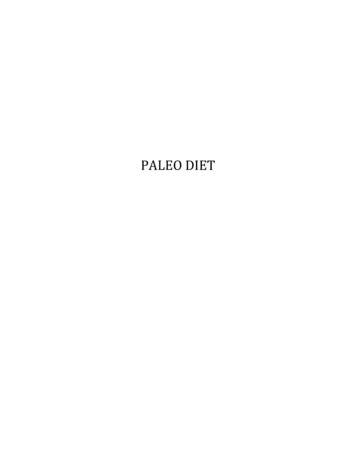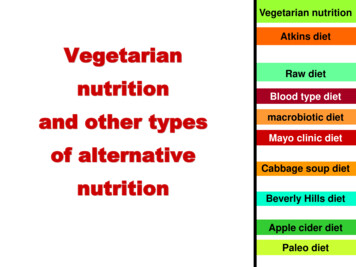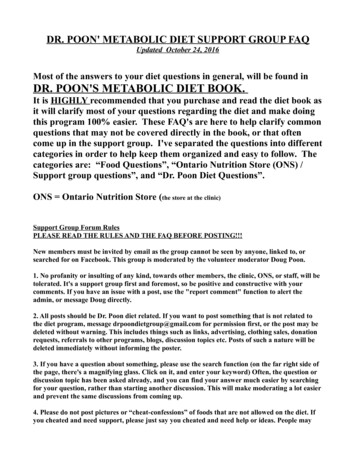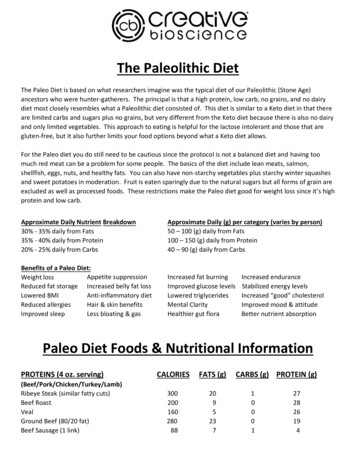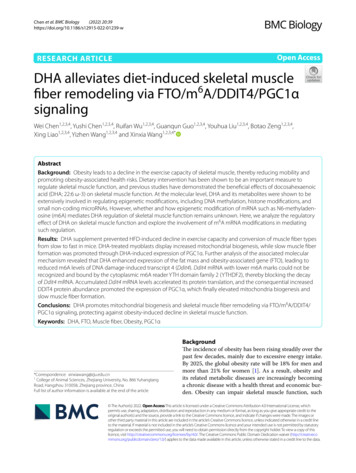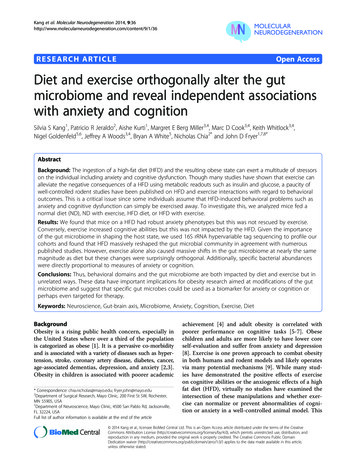
Transcription
Kang et al. Molecular Neurodegeneration 2014, ent/9/1/36RESEARCH ARTICLEOpen AccessDiet and exercise orthogonally alter the gutmicrobiome and reveal independent associationswith anxiety and cognitionSilvia S Kang1, Patricio R Jeraldo2, Aishe Kurti1, Margret E Berg Miller3,4, Marc D Cook3,4, Keith Whitlock3,4,Nigel Goldenfeld5,6, Jeffrey A Woods3,4, Bryan A White5, Nicholas Chia2* and John D Fryer1,7,8*AbstractBackground: The ingestion of a high-fat diet (HFD) and the resulting obese state can exert a multitude of stressorson the individual including anxiety and cognitive dysfunction. Though many studies have shown that exercise canalleviate the negative consequences of a HFD using metabolic readouts such as insulin and glucose, a paucity ofwell-controlled rodent studies have been published on HFD and exercise interactions with regard to behavioraloutcomes. This is a critical issue since some individuals assume that HFD-induced behavioral problems such asanxiety and cognitive dysfunction can simply be exercised away. To investigate this, we analyzed mice fed anormal diet (ND), ND with exercise, HFD diet, or HFD with exercise.Results: We found that mice on a HFD had robust anxiety phenotypes but this was not rescued by exercise.Conversely, exercise increased cognitive abilities but this was not impacted by the HFD. Given the importanceof the gut microbiome in shaping the host state, we used 16S rRNA hypervariable tag sequencing to profile ourcohorts and found that HFD massively reshaped the gut microbial community in agreement with numerouspublished studies. However, exercise alone also caused massive shifts in the gut microbiome at nearly the samemagnitude as diet but these changes were surprisingly orthogonal. Additionally, specific bacterial abundanceswere directly proportional to measures of anxiety or cognition.Conclusions: Thus, behavioral domains and the gut microbiome are both impacted by diet and exercise but inunrelated ways. These data have important implications for obesity research aimed at modifications of the gutmicrobiome and suggest that specific gut microbes could be used as a biomarker for anxiety or cognition orperhaps even targeted for therapy.Keywords: Neuroscience, Gut-brain axis, Microbiome, Anxiety, Cognition, Exercise, DietBackgroundObesity is a rising public health concern, especially inthe United States where over a third of the populationis categorized as obese [1]. It is a pervasive co-morbidityand is associated with a variety of diseases such as hypertension, stroke, coronary artery disease, diabetes, cancer,age-associated dementias, depression, and anxiety [2,3].Obesity in children is associated with poorer academic* Correspondence: chia.nicholas@mayo.edu; fryer.john@mayo.edu2Department of Surgical Research, Mayo Clinic, 200 First St SW, Rochester,MN 55905, USA1Department of Neuroscience, Mayo Clinic, 4500 San Pablo Rd, Jacksonville,FL 32224, USAFull list of author information is available at the end of the articleachievement [4] and adult obesity is correlated withpoorer performance on cognitive tasks [5-7]. Obesechildren and adults are more likely to have lower coreself-evaluation and suffer from anxiety and depression[8]. Exercise is one proven approach to combat obesityin both humans and rodent models and likely operatesvia many potential mechanisms [9]. While many studies have demonstrated the positive effects of exerciseon cognitive abilities or the anxiogenic effects of a highfat diet (HFD), virtually no studies have examined theintersection of these manipulations and whether exercise can normalize or prevent abnormalities of cognition or anxiety in a well-controlled animal model. This 2014 Kang et al.; licensee BioMed Central Ltd. This is an Open Access article distributed under the terms of the CreativeCommons Attribution License (http://creativecommons.org/licenses/by/4.0), which permits unrestricted use, distribution, andreproduction in any medium, provided the original work is properly credited. The Creative Commons Public DomainDedication waiver ) applies to the data made available in this article,unless otherwise stated.
Kang et al. Molecular Neurodegeneration 2014, ent/9/1/36is of critical importance since some individuals assumethat exercise can reverse all negative effects of a HFDincluding behavioral problems such as anxiety or impaired cognition.We now know that obesity involves a number of factors and one of much recent interest has been the roleof the gut microbiota in both weight gain and severeweight loss [10-13]. HFD is known to induce changes inthe commensal gut bacterial community and seminalstudies by the Gordon lab demonstrated that the gutmicrobiota are not merely reflective of the dietary intake,but they are actually key mediators of the metabolicstate [11]. For example, fecal transfers from mice fed aHFD into naïve germ-free recipient mice led to increased adiposity in the recipients even when fed a normal diet (ND) [10]. However, very little is known aboutwhether or how exercise affects the gut microbiome andwhether alterations in the gut microbiome relate tochanges in behavior. Interestingly, germ-free mice areless anxious than conventionally raised mice and recolonization with a normal gut microbiota early in life isanxiogenic [14,15]. In this study we sought to determinethe interaction of HFD and exercise on behavioral outcomes as well as the gut microbial community structureand define their relationships in adult mice. We hypothesized that HFD would cause behavioral problems andalter the gut microbiome but that the effects on both ofthese would be mitigated by exercise. Much to our surprise, we found that both HFD and exercise substantiallyaltered behavior and the gut microbial community butexercise did not normalize or “rescue” the effects of aHFD and, in fact, the relationships were orthogonal.ResultsHigh fat diet causes anxiety that is not attenuated byexerciseTo test the relationship between diet and exercise, we randomly assigned 8-week-old male C57BL/6 J mice to fourgroups: ND, ND exercise, HFD, and HFD exercise(n 10/group). We chose a forced exercise paradigmso that we could precisely control the amount or“dose” of exercise. Importantly, to control for environmental enrichment and handling, non-exercised micewere placed along side their exercising counterparts inrunning wheels that rotated at a speed that just prevented them from sleeping ( 1 m/min). As expected,HFD alone caused a significant increase in body weightcompared to ND as early as 4 weeks after beginningtreatment (Figure 1A). Exercised mice of both groupshad significantly lower body weight than their sedentary counterparts beginning at 5 weeks of treatmentfor ND groups and 8 weeks of treatment for the HFDgroups (Figure 1A). This amount of exercise was notable to completely counteract the effects of the HFD,Page 2 of 12but this was not surprising given the extremely highfat content of this diet (60% kcal from fat) and the limited amount of exercise from these one hour sessions.We performed behavioral testing of these groups todetermine the impact of HFD or exercise on anxiety andcognition. Open field analysis did not demonstrate anysignificant differences in total activity or rearing amongthe groups (Additional file 1: Figure S1). We also foundno differences between the groups in sociability asmeasured in the three-chamber social interaction test(Additional file 1: Figure S1). Using the light/dark exploration apparatus as a measure of anxiety, we foundthat mice fed a HFD were significantly more anxiousas measured by percentage of time spent in the lightcompartment and in distance traveled while occupyingthe light compartment (Figure 1B and C). However, exercise was not able to counteract these anxiogenic effects of the HFD (Figure 1B and C).Exercise improves memory but is not impacted by highfat dietWe next measured learning and memory in the contextual fear conditioning paradigm where mice are placed ina chamber and a loud tone is paired with a negativestimulus (foot shock). Mice that remember the environment will spend more time freezing when placed againin the same apparatus (contextual memory). Exercisedmice on a normal diet had significantly increased contextual memory compared to their sedentary counterparts (Figure 1D). Exercised mice on a HFD diet had atrend toward increased contextual memory compared totheir sedentary HFD counterparts, but this effect did notquite achieve statistical significance (Figure 1D). Similarresults were obtained with the cued portion of the task(Additional file 1: Figure S1). However, HFD alone didnot substantially alter either contextual or cued memorynor did it significantly reduce the positive effects ofexercise.Effect of diet and exercise on the gut microbiomeWe also assessed whether exercise alone or in the context of a HFD could alter the gut microbial community.We purified DNA from fecal samples from each of themice and profiled their gut microbiome using next generation barcoded sequencing of amplicons from the variable regions V3-V5 of the bacterial 16S ribosomal DNA(a “fingerprint” of different bacterial taxa). A total of35,197,991 reads were obtained from 40 samples (averaging 879,950 249,310 reads; minimum 431,900 reads;maximum 1,416,925 reads) using a 300-cycle kit on asingle Illumina MiSeq sequencing run. Paired reads werethen analyzed using an extension of the TORNADOpipeline for taxa, operational taxonomic unit (OTU),and phylogeny [16]. QIIME [17,18] was used to calculate
Kang et al. Molecular Neurodegeneration 2014, ent/9/1/36Page 3 of 12Figure 1 Effects of diet and exercise on body weight, anxiety, and cognitive behavior. (A) HFD-fed mice were significantly heavier startingat 4 weeks of treatment (ND vs HFD) while exercised mice weighed significantly less at 5 weeks of treatment for ND groups (ND vs ND exercise, *p 0.05)and at 8 weeks of treatment for HFD groups (HFD vs HFD exercise, * p 0.05). HFD-fed mice were more anxious as measured in the Light/Dark explorationassay for both percentage of time spent in the lit compartment (B) and distance traveled while in the lit compartment (C). Exercised mice hadenhanced learning and memory measured in the contextual fear conditioning assay (D). Body weight analyzed by repeated measuresANOVA with post-hoc t-test and significance defined as p 0.05. Behavioral data was analyzed by two-way ANOVA with post-hoc Fisher’sLSD with significance indicated as *p 0.05, **p 0.01, and ***p 0.001. All data presented as mean /- SEM from n 10/group.beta-diversity, which was then visualized using R withthe vegan package for ordination plots.Our initial hypothesis was that exercise would rescuemany of the shifts in the gut microbiome caused by aHFD. While we found a few examples where exercisemodulated HFD-induced changes in the microbiome, including a remarkable “bloom” of a Streptococcus genus(OTU115, family Streptococcaceae, order Lactobacillales)that was returned to undetectable levels with exercise(Figure 2A), the majority of microbiome alterationsexerted by diet and exercise followed an unexpectedpattern. Not only did exercise alone cause large shiftsin the two most abundant phyla, Firmicutes and Bacteroidetes, but the directionality and magnitude ofthe effect was similar to the changes caused by HFD(Figure 2B,C). Both diet and exercise also independently decreased the relative abundance of Tenericutes(Figure 2D).While the changes in phyla induced by HFD or exercise appear similar, this broad grouping of bacteria doesnot provide the resolution for determining the effects ofdiet or exercise on the community structure. In order torefine the analysis, we analyzed these data at the OTUlevel with each OTU representing bacteria grouped at97% identical sequences from the 16S sequencing (seeMethods). Metric Dimensional Analysis (MDA) is onesuch way to visualize similarities or dissimilarities inlarge data sets while preserving their distance relationships. MDA revealed that a high percentage of variationis explained by just the first and second principal components with each of the four groups of mice separatingrather cleanly into four distinct clusters (Figure 3). Thisindicates that most diet- or exercise-induced shifts inmicrobial populations are completely unrelated (i.e. orthogonal). More detailed examination of what drives thisseparation in ordination space revealed multiple strongsignatures separating ND from HFD groups and secondarily separating sedentary from exercised groups (Figure 4with OTU probabilities shown in Additional file 2:Table S2). Additionally, we analyzed different levels oftaxonomy and found significant main effects of diet onthe abundance of many different families and an equalnumber of main effects of exercise (Table 1). Severalmain effects of diet or exercise were also seen at higherlevels of taxonomy such as order, class, and phylum(Additional file 3: Table S1).
Kang et al. Molecular Neurodegeneration 2014, ent/9/1/36Page 4 of 12Figure 2 Changes in the relative abundances of gut bacteria by HFD or exercise. (A) HFD caused a bloom of OTU115 from the genusStreptococcus that returned to nearly undetectable levels in HFD exercise mice. Bacterial of phyla Firmicutes (B), Bacteroidetes (C), andTenericutes (D) of the gut microbiome were significantly altered by both HFD and exercise. Data was analyzed by two-way ANOVA with post-hocHolm-Sidak t-tests with significance indicated as *p 0.05, **p 0.01, ***p 0.001, and ****p 0.0001. All data presented as mean /- SEMfrom n 10/group.Associations between specific taxa with anxiety andcognitionWe next wanted to test whether specific taxa would correlate with behavioral measures. We analyzed the top 100OTU’s and found that the relative abundance of OTU69,OTU90, and OTU97, all from the family Lachnospiraceae,positively correlated with % time in light, that is higherlevels correlated with less anxiety (Figure 5). OtherFigure 3 Multidimensional analysis of diet and exercise revealsorthogonal changes in the gut microbiome. This analysis inmultidimensional space demonstrates clear segregation of each ofthe four groups of mice with no overlap between groups.specific bacteria such as OTU17 (family Lachnospiraceae), OTU30 (family Streptococcaceae, genus Lactococcus), OTU72 (family Ruminococcaceae), and OTU89(family Ruminococcaceae, genus Butyricicoccus) negatively correlated with% time in light, that is lowerlevels correlated with less anxiety (Figure 5). In fact,anxiety relationships were found at all levels of taxonomy including family, order, class, and even phylum(Additional file 4: Figure S2), although with these sample sizes they did not reach statistical significancewhen corrected for false discovery rate. We also foundweaker associations with cognitive performance between bacteria from the order Clostridiales such asOTU39, 82, 79, and 57 (Figure 6), although these alsodid not quite reach significance when corrected forfalse discovery rate. Nevertheless, it is interesting thatthey all fell within a single order (Clostridiales). Inagreement with numerous other studies, several highlysignificant relationships with body weight were seen atall levels of taxonomy including the phyla Bacteroidetes, Firmicutes, and Proteobacteria (Additional file 5:Table S3).DiscussionVery few studies have examined how exercise alone impacts the gut microbiome. Voluntary exercise in rats
Kang et al. Molecular Neurodegeneration 2014, ent/9/1/36Page 5 of 12Figure 4 Heat map of global analysis of diet and exercise reveals multiple distinct signatures with clear dietary effects and secondaryexercise effects.caused global changes in the gut microbiome but thetechnique used in those studies (PCR banding patterns)is only useful in determining whether differences existand cannot be used to ascertain which bacteria are altered [19,20]. One study found that voluntary exercise inmice caused large alterations in the gut microbiome andwith clear separations in ordination space [21], but thetechniques used (PhyloChip arrays) make it difficult orimpossible to compare to our data given the differences in accurately assigning bacteria to different taxa.Interestingly, one study that employed deep sequencing techniques failed to find significant changes in thegut microbiome [22], but they used voluntary wheelrunning and their first sampling of the microbiomewas after 1 year of exercise compared to our changesfound at 16 weeks. A recent study of similar designand duration to ours also found that diet and exerciseexerted orthogonal effects on the gut microbiota [23].However, they reported that exercise increased Bacteroidetes and decreased Firmicutes (opposite of our results) perhaps due to their voluntary wheel runningparadigm [23].Due to the nature of studying the interaction of exercise and diet, which requires subjects to be fed a high fatdiet as one of the conditions, it is unlikely that similarstudies will ever be conducted in humans. Therefore, itis important to understand how these factors interact ina well-controlled animal model system in order to determine how these parameters may impact human health.Although numerous studies have shown the benefits ofexercise on cognitive function [7,24,25] as we have demonstrated here, few studies have actually examined theinteraction between HFD and exercise, specifically in regard to behavioral outcomes. Rat studies have suggestedthat exercise can partially rescue the cognitive declineassociated with HFD; however, an important parameterof behavior, anxiety, was not measured in these studies[26,27]. Our current study clearly indicates that exercisealone is unable to counteract all of the effects of a HFD.This is a critical finding given that some humans likelyoperate under the assumption that exercise can completely reverse the negative impact of HFD and changehow we view weight loss that is conducted through exercise alone.
Kang et al. Molecular Neurodegeneration 2014, ent/9/1/36Page 6 of 12Table 1 Significant effects of diet and exercise at the level of familyMain effects 2 way ANOVAFamilyHigh fat dietExercisePorphyromonadaceae **** ***Streptococcaceae **** ** *Post-hoc testingInteraction*ND vsND ex vsND vsHFD vsHFDHFD exND exHFD ex***************Lachnospiraceae ************Erysipelotrichaceae *********Clostridiaceae 1 **********Ruminococcaceae ****Peptostreptococcaceae ***Eubacteriaceae ***Peptococcaceae 1 **Anaeroplasmataceae **Staphylococcaceae **Cryomorphaceae * *** ** **Phyllobacteriaceae * * * *Pseudomonadaceae * *Bacteroidaceae *Veillonellaceae * *Lactobacillaceae *Gracilibacteraceae *********************Peptococcaceae 2 ***Rhizobiaceae **Incertae Sedis IV **Microbacteriaceae *Nocardiaceae *Coriobacteriaceae *Flavobacteriaceae *Sphingobacteriaceae *******Bradyrhizobiaceae *Caulobacteraceae **Burkholderiaceae **Comamonadaceae **P 0.05, **P 0.01, ***P 0.001, ****P 0.0001.Somewhat to our surprise, our data suggest that HFDand exercise independently impact the different behavioraldomains of anxiety and cognition, much like the orthogonal effects on the gut microbiome. Though the cognitionassociations with specific OTUs were weaker compared toanxiety, we nonetheless found significant relationships thatall fell within Clostridiales, a diverse taxonomic orderwithin the phyla Firmicutes that has not been previously associated with cognition. Clearly further studies with largersamples sizes are required to confirm these associations.Numerous studies have described how the gut microbiome is altered by a HFD and obesity including changesin Firmicutes and Bacteroidetes [28-31]. Though only avery minor phylum in terms of representation, we alsofound that HFD reduced the relative abundance ofTenericutes, driven almost entirely by a single OTU(#67) from the genus Anaeroplasma ( 99% probabilityas shown in Additional file 2: Table S2) that has notbeen previously implicated in dietary manipulations.HFD induced large changes at all levels of taxonomy,
Kang et al. Molecular Neurodegeneration 2014, ent/9/1/36Page 7 of 12Figure 5 Several bacteria significantly associate with anxiety measures. Relative abundances of OTU69, 90, and 97 positively correlatedwith % time in light in the Light/Dark test (A-C) while OTU17, 30, and 72 negatively correlated with % time in light (D-F). Most likely familyor genus shown on graph. Color scheme of data points follows the format as in Figure 1 (ND blue, ND exercise green, HFD red,and HFD exercise in orange). Linear regression analysis for individual mice was performed with R2 values indicating goodness of fit and p values(indicated on graph) for slope calculated by F test with Benjamini-Hochberg correction for false discovery rate.Figure 6 Several bacteria specifically associate with cognitive measures. (A-D) The relative abundance of OTU’s 39 and 82 negativelycorrelated with % time freezing in the contextual fear conditioning test (A, B) while OTU79 and 57 positively correlated with % timefreezing (C, D). Most likely family or genus shown on graph. Color scheme of data points follows the format as in Figure 1 (ND blue,ND exercise green, HFD red, and HFD exercise in orange). Linear regression analysis for individual mice was performed withR 2 values indicating goodness of fit and uncorrected p values (indicated on graph) for slope calculated by F test.
Kang et al. Molecular Neurodegeneration 2014, ent/9/1/36including in the two most abundant classes/orders(Bacteroidia/Bacteroidales and Clostridia/Clostridiales). Wealso found HFD caused many significant changes in taxa ofmore minor abundance. For example, highly significant alterations were seen for several orders (e.g. Lactobacillales,Erysipelotrichales, and Anaeroplasmatales) and classes(e.g. Erysipelotrichia, Mollicutes, and Bacilli). Subsequentstudies will determine which of these are the most important players, but probiotic studies support the idea thateven taxa of minor abundance can still elicit large effectson the host. Current methods of bacterial profiling as wehave used here do not provide sufficient coverage of theentire 16S region to reliably identify changes at the specieslevel, but such studies would allow for more direct translational potential of findings (e.g. pre- or probiotics).Many studies have documented the negative consequences of dietary fat intake and obesity on behaviorand brain function in rodents [32-36]. Diet-inducedobesity has been shown to promote depressive-like behavior due to altered brain reward circuitry in mice [32].Interestingly, caloric restriction has been shown to reduce anxiety and depression related behaviors in mice[37]. One study demonstrated HFD-induced anxiety behavior and changes in the gut microbiome at the level ofphylum, but the techniques used did not allow for highresolution analysis [38]. In addition to low anxiety phenotypes in germ-free mice [14,15], some studies haveshown that modulation of the gut microbiota either bydiet or probiotics can impact anxiety [39,40]. The majority of anxiety associations from our study were a subsetof the same taxa that associated with body weight. Interestingly, alterations of Ruminococcaceae and Lachnospiraceae were found in mice exposed to a grid floorstress paradigm [41]. We found a few associations withanxiety that were independent of body weight alterations,including OTU37 (Ruminococcaceae; Clostridium IV),OTU40 (Barnesiella), and OTU48 (Eubacterium), andthese as well as OTU30 (Lactococcus) have no reportedassociations with anxiety. It is important to point out thatwe cannot establish causality from these studies. Indeed,others have found that manipulations that cause anxiety inrodents can also result in changes to the gut microbialcommunity [42,43]. These “top down” vs “bottom up” dynamics between the CNS and the gut microbiota requirefurther study to fully delineate the causality, but it is highlylikely that both mechanisms are at play with some feedbackat both levels (i.e. a true system). Likewise, further studieson high fat diet and exercise are required to determinewhether these specific bacteria are biomarkers of anxietyor actually drivers of the anxiety phenotypes or both.Page 8 of 12but not HFD, was able to enhance cognition. We alsofound that exercise alone robustly altered the gut microbial community and did not rescue the changes inducedby a HFD but, in fact, the changes caused by exercise werecompletely orthogonal to those induced by a HFD. Additionally, we found numerous, independent associations ofspecific OTUs and taxa with body weight, anxiety, andcognition that will need to be empirically tested to determine their importance. These data have important publichealth implications not only in terms of obesity butalso determining how the gut microbial community relates to behavioral domains and how it may be used asa biomarker or reshaped to effect changes in anxietyand cognition.MethodsMice and treatmentsAdult male C57BL/6 J mice were purchased from JacksonLaboratories (Bar Harbor, MN) and were randomly assignedto n 10/group . Beginning at 8 weeks of age, mice wererandomized to one of four groups: ND, ND exercise, HFD,and HFD exercise. Diet consisted of normal diet (10% ofcalories from fat; Research Diets, New Brunswick, NJ#D12450B) or high fat diet (60% of calories from fat; Research Diets #D12492). After an initial 2 week trainingperiod where the speed was gradually increased from 3 to7 m/min and duration from 6 to 60 minutes per day, exercised groups were placed in running wheels (Lafayette Instruments, Lafayette, IN) for one hour at 7 m/min everymorning for 5 days/week for the remainder of the studywith the exception of the behavioral testing days. Control“sedentary” groups were placed in adjacent running wheelsthat rotated at a speed that just prevented them from sleeping ( 1 m/min) to control for environmental enrichmentand handling. All procedures were in accordance withguidelines from the Institutional Animal Care and UseCommittee under an approved protocol.Behavioral analysisFor all behavioral tests, mice were acclimated in theroom for an hour prior to the onset of testing. Data wasrecorded and monitored using overhead cameras andtracked with Anymaze software (Stoelting Co., WoodDale, IL). Three days following the last exercise session,mice were tested on consecutive days in the open fieldassay, light/dark box, three-chamber social apparatus,and contextual fear conditioning (over two days) alwaysin the first half of the light phase.Open field assay (OFA)ConclusionsIn this study we found that a HFD was able to cause significant anxiety with no rescue by exercise while exercise,Mice were placed in a 40 40 30 cm (W L H)opaque Perspex box and activity was tracked during theentire 15 minute observation period.
Kang et al. Molecular Neurodegeneration 2014, ent/9/1/36Light/Dark exploration (LDE) assayMice were placed in a square 40 40 30 cm Perspexbox equally divided into two compartments with a smallopen door joining the light and dark compartments. Thedark compartment was completely covered and micewere tested by placing them at the far end of the litchamber facing away from the dark chamber and theiractivity was tracked for 10 minutes.Three chamber social interaction (3SI)Social behavior was tested in a three-chamber Perspex40 40 cm box consisting of two 17x40 cm regions separated by 2 dividers forming a smaller 5 40 cm centerregion. Mice were able to move freely through a small8 5cm opening that was aligned in both dividers. Eachof the larger chambers contained an inverted wire meshcylinder in opposing corners. Mice were initially acclimated to the box and empty cylinders for 4 min andthen placed in temporary holding cages. A male probemouse of the same strain was placed in one of theinverted mesh cylinders and allowed to acclimate for3 minutes prior to placing the test mouse back in thebox. The open mesh enabled visual, olfactory, and auditory interactions between probe and test mice. Test micewere subsequently monitored for 10 min in the presenceof the probe mouse and interaction score was calculatedwith the following formula: (Time Mouse cup – Timeempty cup)/ (Time Mouse cup Time empty cup).Contextual fear conditioning assay (CFC)This test was conducted in a sound attenuated chamberwith a grid floor capable of delivering an electric shockand freezing was measured with an overhead cameraand FreezeFrame software (Actimetrics, Wilmette, IL).Mice were initially placed into the chamber and undisturbed for 2 minutes, during which time baseline freezing behavior was recorded. An 80-dB white noise servedas the conditioned stimulus (CS) and was presented for30 sec. During the final 2 sec of this noise, mice receiveda mild foot shock (0.5 mA), which served as the unconditioned stimulus (US). After 1 minute, another CS-USpair was presented. The mouse was removed 30 sec afterthe second CS-US pair and returned to its home cage.Twenty-four hours later, each mouse was returned tothe test chamber and freezing behavior was recorded for5 minutes (context test). Mice were returned to theirhome cage and placed in a different room than previously tested in reduced lighting conditions for a periodof no less than one hour. For the auditory CS test, environmental and contextual cues were changed by: wi
High fat diet causes anxiety that is not attenuated by exercise To test the relationship between diet and exercise, we ran-domly assigned 8-week-old male C57BL/6 J mice to four groups: ND, ND exercise, HFD, and HFD exercise (n 10/group). We chose a forced exercise paradigm so that we could precisely control the amount or "dose" of exercise.



